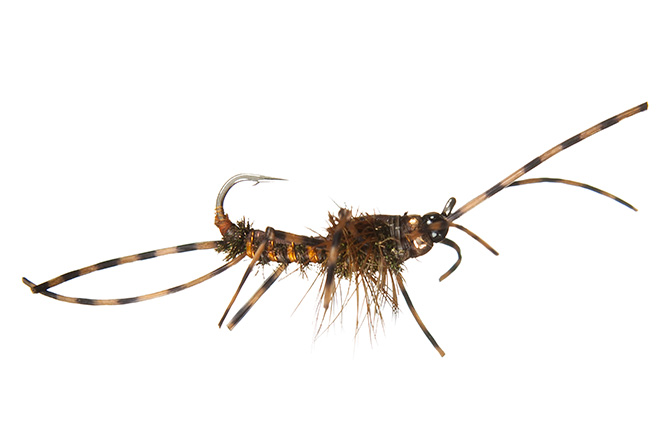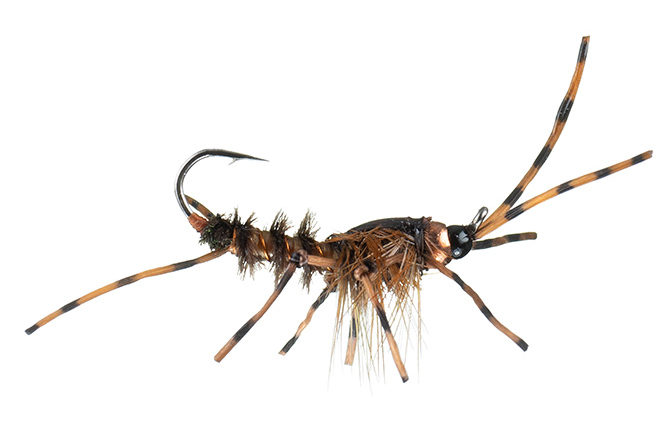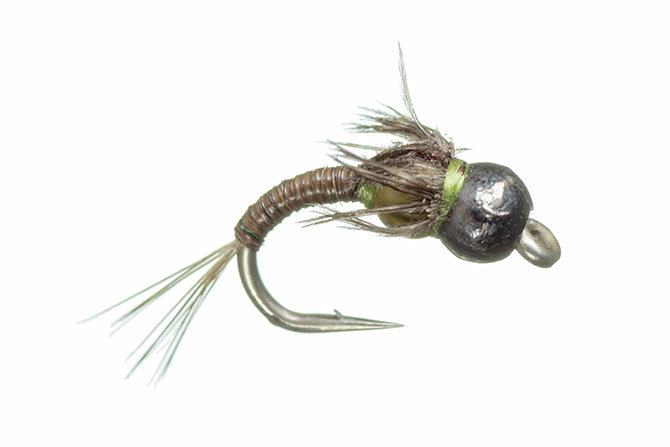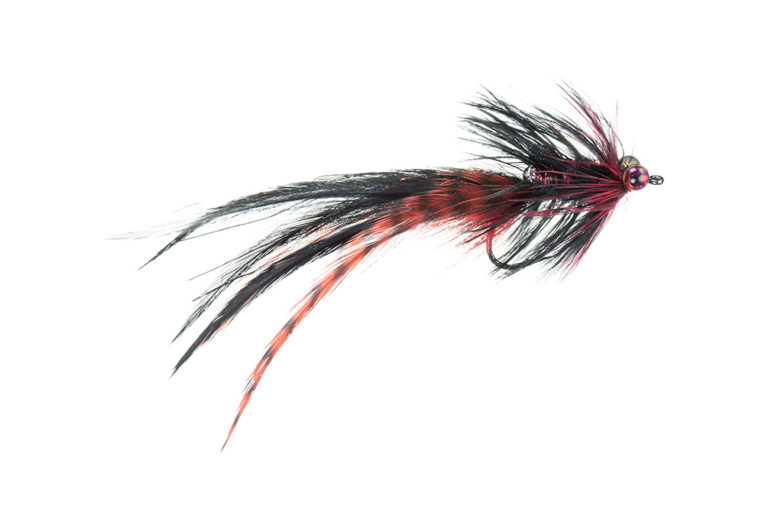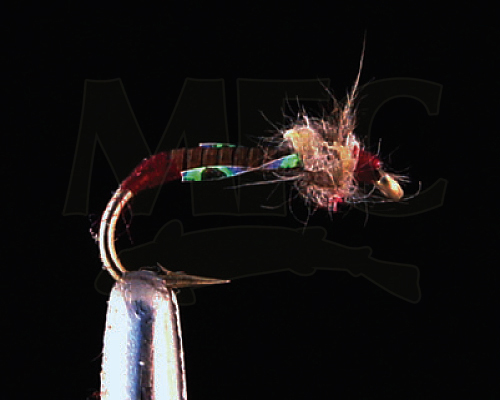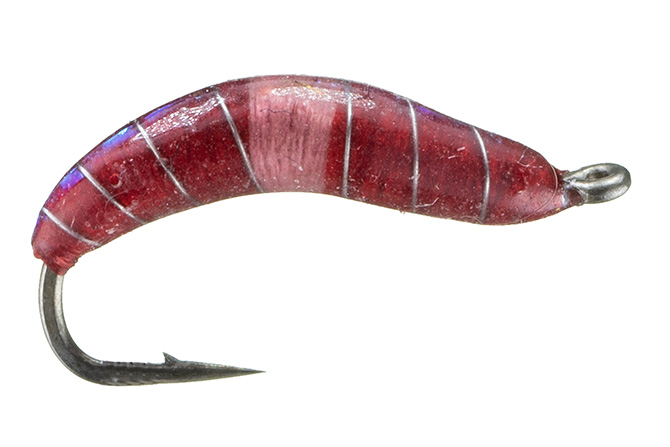flies
Smethurst's Heater Bomb
The Heater Bomb is a slightly more colorful Stonefly Nymph that I developed over the last thirty years that mixes Orange and Peacock body materials along with Burnt Orange barred rubberlegs. This fly is better than others in the Stone Bomb family where there are more and brighter Golden Stones, colder and dirtier water, and wherever Steelhead are found. Steelhead love the Heater Bomb to an inexplicable degree, and from the Great Lakes to the PNW and Alaska, this is a great Steelie Nymph.
Smethurst's Drake Bomb
There are few western hatches as treasured as a green Drake Hatch, and the Drake Bomb is how I fish the time before the hatch when fish are often really selective to their nymphs. Green Drake Nymphs are a stubby and wide nymph that are often found in some slower water. This gives the fish a chance to really look at the nymph and thats where the Drake Bomb prevails. Its also really strong during the rest of the year on those rivers that have a Drake population. Designed to also ride hook up and skim along the bottom with less snags, these flies are super deadly.
Smethurst's Stone Bomb
All of the Stone Bombs are Dark Brown/Tan and Amber Sexi Floss Legs. Stone Bombs are designed to be the fly that you use when you are in clearer water and flies like the Pats Rubber legs are falling a bit short. These upside down riding stones come in smaller sizes and because they are glued together and quite heavy, offer a little bit more technical option than the typical Stonefly. Its rare that these arent an incredibly effective point fly and these are also highly effective when used with either Euro or American style rigs. They are also a really solid Carp and Bass nymph whenever more precision shallow water sightfishing is called for, as the flies will walk along the bottom and not snag which allows for a great presentation.
Smethurst's Twenty Bomb
The Twenty Bomb is special. I transplanted the exact paint job of the reknowned Twenty Incher nymph from Colorado into my Bomb format and it has become legendary. I have caught big fish on this from California’s Coast, to the Deep Southern Tailwaters and everywhere in between. Because it rides upside down, this is a particularly handy fly to have on a snaggy bottom as you can drift it more dangerously deep and hop it along that bottom. In early season, I like the overly leggy look of these flies buty for clearer water or to increase sink rate, I will often trim the legs or the antennae on all of these flies to suit.
Smethurst's Crane Bomb
The inspiration for the Crane Bomb came from some of my favorite lower elevation Tailwaters where Craneflies were big medicine. New Mexico, Utah and Wyoming are all really big centers of Cranefly populations, and where anglers commonly fish Cranes. I first tied the fly in San Luis Colorado while holed up in a hotel and waiting out a snowstorm. I had forgotten my vice, and just whipped the first one by holding the hook by hand and winding various colors of Ostrich onto the shank. The fly worked well immediately, and has become my go to fly for areas where the cranefly is a big part of the menu. I also like that the smaller sizes of the Crane Bomb serve as a strong Caddis imitation and they all excel at being a heavy nymph that you can count on to reach bottom. I find that this fly is just the trick for rivers that dont have a large stonefly population, but you need a bigger and still relevant point fly to get down.
Smethurst's Baetis Bomb
Seemingly on every Trout River on the planet there are Baetis or Blue Winged Olive nymphs, and the Trout feast upon them throughout the year. Drab, slim, durable and heavy with olive and flat black beads, the Baetis Bomb is tied on a strong MFC Scud hook with subtle legs, and utilizes stripped peacock quill under glue for a body. this is one of the deadliest small nymphs I have ever created. The Baetis Bomb is an excellent and highly imitative pattern as either a stand alone nymph or a fantastic dropper. Designed on challenging waters all over the southern Rockies, this small nymph is available from a #14-#22 and is ready to fool those tough fish wherever you are going.
Smethurst's Searcher
A hackle streamer was the very first Saltwater fly used in the Everglades by Homer Rhodes. His first Tarpon and Snook flies looked much like these, and I have often noticed that returning to the feather streamer is often what the fish were waiting for. Add select hackle, a rattle, MFC Dazl-eyes and a Gammakatsu Stinger hook and you make this fly one of the deadliest all-rounder patterns I have ever used. I call it the Searcher because it is that perfect combination of sound and profile. It lands lightly, but sinks nicely. The rattle helps when there is some blind casting or the water is not so clear, and I find that the profile is equal parts Baitfish, Shrimp, Squid and Eel. Peacocks, Redfish, Pike, Bass, Seatrout, Tarpon, Snook, Trout and Stripers are all big fans of The Searcher. This fly comes in a variety of fundamental colors, and is one of my most versatile patterns for both Fresh and Salt.
Smethurst's Hemorrhoidal Mouse
Long before the film Eastern Rises, the Hemorrhoidal Mouse is the fly that I created while guiding in Alaska, and also to win the U.S. Flyfishing Masters. In the Masters, a tourney held all over America in the early 2000’s, the Hemmorhoidal Mouse allowed us to raise one big fish after another and we were the only anglers fishing a mouse. I first tied the fly as a guide in Bristol Bay Alaska, and the hot butt of the fly serves to help further attract those fish that need an extra visual and eggy trigger. Kind of a hot spot as seen from below. Those fish that smash an indicator or just prefer something eggy are a big influence on the creation of the HM, and its now proven all over the lower 48 for Bass Trout, Pike and Steelhead as well as Alaska and of course Kamchatka and anywhere else that Mice are a thing.
Smethurst's Voodoo Midge
Guiding and fishing for really difficult Midge centric fish over many years, the Voodoo Midge took about two decades to get right. This is the fly when a beadhead is too much and a slimmer profile is required. From the glued Peacock Quill body to the sprigs of tinsel wing to the thread hot spots and culminating in a fluffy gray head dubbed with a secret ingredient that provides movement even on this small scale. Each of these elements combine to make a highly imitative midge and micro caddis. Designed to be fished in the film, the column or along the bottom in tandem with another nymph, this fly continues to be a winner and has earned a strong place in any tailwater anglers box.
Smethurst's Midge Bomb -Black
The Midge Bomb is tough to beat when Zebra midges wont cut it and a more subdued fly is needed. One that is heavy enough to get down in some heavier water. Additionally, the durability of the fly, encased in glue as it is, becomes a real consideration. Heavy, but not too heavy, it is great as a trailing dropper nymph off of a dry or another wet.
Smethurst's Worm Bomb
I know, I know, this thing is an aberration, an embarassment, a truly base and vile thing……….Thats okay, its all true, but sometimes thats exactly what you need in a worm imitation. Particularly when you need a heavier point fly to get down near the bottom, this is what it should look like. This fly is weighted by both lead and its Epoxy coating, so its medium heavy, durable, comes in an array of Wormy colors, and works all too well wherever trout are found.
